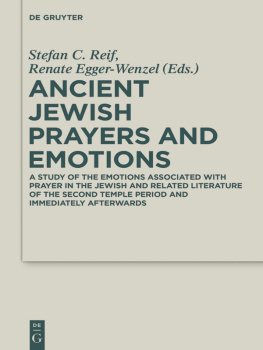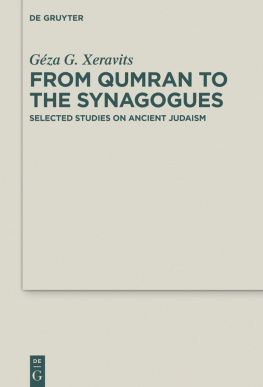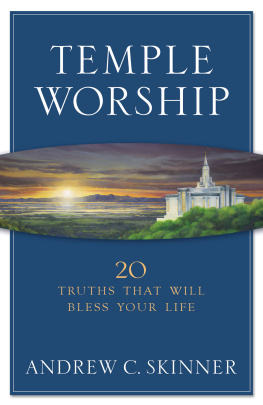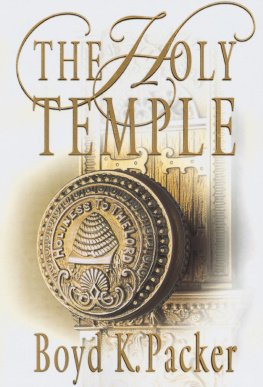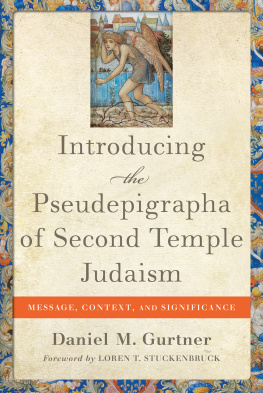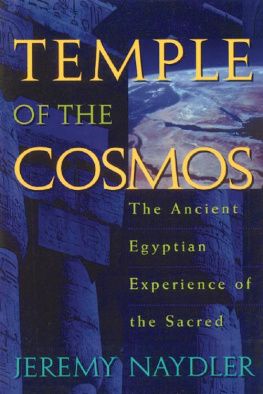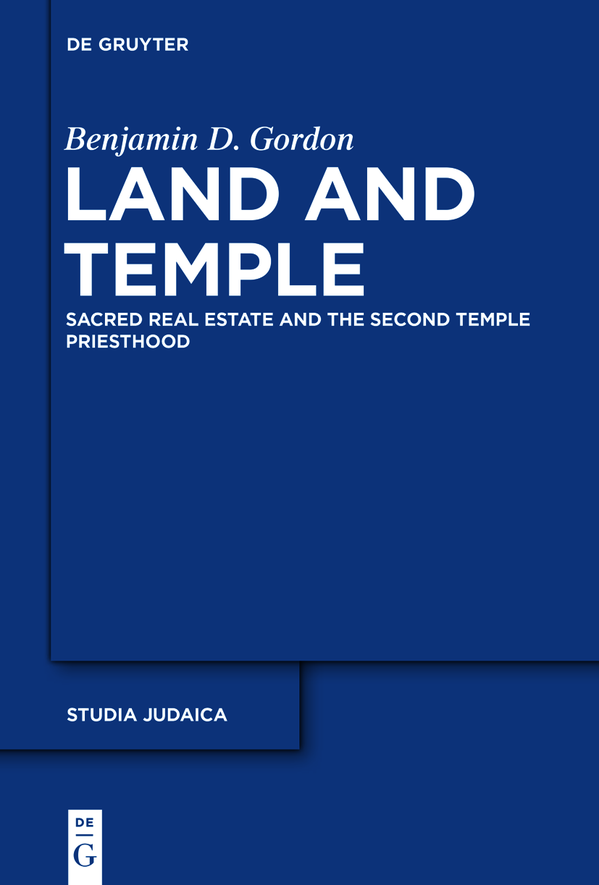Studia Judaica
Forschungen zur Wissenschaft des Judentums
Edited by
Ernst L. Ehrlich
Gnter Stemberger
Charlotte Fonrobert
Elisabeth Hollender
Alexander Samely
Irene Zwiep
Volume
ISBN 9783110425468
e-ISBN (PDF) 9783110421026
e-ISBN (EPUB) 9783110421163
Bibliographic information published by the Deutsche Nationalbibliothek
The Deutsche Nationalbibliothek lists this publication in the Deutsche Nationalbibliografie; detailed bibliographic data are available on the Internet at http://dnb.dnb.de.
2020 Walter de Gruyter GmbH, Berlin/Boston
Acknowledgments
This book developed out of a doctoral dissertation I completed in 2013 in the Graduate Program in Religion at Duke University. Initially the project was to be about the settlement patterns of Judean priestswhere and how they lived outside of Jerusalem, and how their presence impacted village life. I began by examining the question of the priests role in land management and never got much further than that, deciding in the end to write the dissertation on field consecrations in ancient Judaism. My heartfelt thanks go to my doctoral advisor, Eric Meyers, for his mentorship, guidance, and friendship through the years. I was also privileged to have Stephen Chapman, Laura Lieber, Evyatar Marienberg, and Joshua Sosin on my doctoral committee. The Perilman endowment of the Jewish Studies Program at Duke provided generous funding when I was a doctoral student.
Joshua Sosin has continued to work with me in developing a new reading of Lev 27, a source that is very important to this project. Years ago, he suggested that the chapter could be about securities on debt. Initially I disagreed, holding fast to the idea, which is well established already in rabbinic exegesis, that it is about donations to God. Eventually I came to agree with Josh. My thanks go to him for the idea and for his willingness to continue to work with me in developing it.
For the past four years my institutional home has been the Department of Religious Studies at the University of Pittsburgh, where I have benefitted from conversations with colleagues and students about this book. I am particularly grateful to Adam Shear and the late Linda Penkower for their support as department chairs, and to the Deans office in the Dietrich School of Arts & Sciences at Pitt for granting me a semester off from teaching to work on the book. Since 2017, the Rosenberg-Perlow endowment at Pitt has allowed me to spend more time on research. Thanks also go to my research assistants Natasha Mayer and Sydney OBrien of the First Experiences in Research program for all their hard work.
I presented some of the material in this book at conferences over the years and have benefitted from the feedback I received at them. Particularly fruitful were discussions with Andrew Monson, Carolin Arlt, Marie-Pierre Chaufray, Ann Goddeeris, and Lidia Matassa at the Irish Society for the Study of the Ancient Near Easts third annual conference on Money and Cult: The Role of the Temple in the Ancient Economy. Also helpful were responses from participants in a conference at the Israel Institute for Advanced Studies of the Hebrew University of Jerusalem on Expressions of Cult in the Southern Levant in the Greco-Roman Period. Some of the content of Chapters 5 and 6 below appears in my contribution to the conference volume: Debt Fraud, Herem Entrapment, and Other Crimes Involving Cultic Property in Late Hellenistic and Early Roman Judea, pages 25567 in Expressions of Cult in the Southern Levant in the Greco-Roman Period. Manifestations in Text and Material Culture, edited by Zeev Weiss and Oren Tal (Turnhout: Brepols, 2017).
I published my interpretation of Romans 11:16, which appears in Chapter 7 below, in the article On the Sanctity of Mixtures and Branches: Two Halakhic Sayings in Romans 11:16, Journal of Biblical Literature 135, no. 2 (2016): 35568. I would like to thank Rebecca Denova, Douglas Campbell, T.J. Lang, Joel Marcus, and the participants in the Duke-UNC New Testament and Judaic Studies Colloquium for their assistance as I worked on that material, the results of which are in Chapter 7.
I am grateful to my readers in the Studia Judaica series at de Gruyter, particularly Alexander Samely and Gnter Stemberger, for the careful attention they gave the manuscript. Alice Meroz and Sophie Wagenhofer in the editorial department were patient and helpful along the way, Jana Fritsche proofread the manuscript and saw it through to publication, and Florian Ruppenstein managed the production process. Nelly Beyman of the Israel Antiquities Authority helped me secure permissions to use several images.
Finally, I would like to give thanks to my family for all their support over the years, as well as to my partner James Arjmand. He tolerates my occasional distractedness with good cheer, provides reassurance, and laughs with me after a hard days work.
Benjamin D. Gordon
Pittsburgh, Pennsylvania
Abbreviations
Ant.
Josephus, Jewish Antiquities
b.
son of (ben)
b.
Babylonian Talmud
BHS
Biblia Hebraica Stuttgartensia
C. Ap.
Josephus, Against Apion
CD
Damascus Document (Cairo Geniza)
CPJ
Corpus Papyrorum Judaicarum
DSD
Dead Sea Discoveries
FAT
Forschungen zum Alten Testament
HTR
The Harvard Theological Review
HUCA
Hebrew Union College Annual
IEJ
Israel Exploration Journal
INJ
Israel Numismatic Journal
JBL
Journal of Biblical Literature
JESHO
Journal of the Economic and Social History of the Orient
JJS
Journal of Jewish Studies
JNES
Journal of Near Eastern Studies
JPS
Jewish Publication Society
JSJ
Journal for the Study of Judaism
JSNT
Journal for the Study of the New Testament
JSOT
Journal for the Study of the Old Testament
JSOT Supp.
Journal for the Study of the Old Testament Supplement Series
LAB
Pseudo-Philo, Liber Antiquitatem Biblicarum
LXX
Septuagint
m.
Mishnah
MT
Masoretic text of the Hebrew Bible
NRSV
New Revised Standard Version
PAM
Palestine Archaeological Museum
R.
Rabbi
Rahlfs
Alfred Rahlfs (ed.), Septuaginta
RB
Revue Biblique
t.
Tosefta
VT
Vetus Testamentum
War
Josephus, Jewish War
y.
Palestinian/Jerusalem Talmud
Figures
Figure 1.
Jerusalem and surroundings in the first century CE. Illustration by Balage Balogh.
Figure 2.
Franciscan Monks making hay in Ottoman Palestine, ca. 1903. Library of Congress Prints and Photographs Division. Stereograph by C.H. Graves.
Figure 3.
Map of the Persian provinces of Judea and Samaria.
Figure 4.
Judahite stone scale weights in various denominations. Courtesy of the Israel Antiquities Authority. Photo: Miki Koren.
Figure 5.
The Paleo-Hebrew Leviticus Scroll from Qumran. 11QpaleoLev, Col. 6, Lev 27:1119. Courtesy of The Leon Levy Dead Sea Scrolls Digital Library; Israel Antiquities Authority.
Figure 6.
Farmers plowing their field in Ottoman Palestine, ca. 1900. Library of Congress Prints and Photographs Division. Photographic print from the Frank and Frances Carpenter Collection.
Figure 7.
The sacred reserve (in grey) in Ezekiels Temple Vision. It is situated within an extra-tribal territory with land allotted for the city and prince as well.
Figure 8.
Laborers in the fields of Sanur in Ottoman Palestine, c. 1908. Library of Congress Prints and Photographs Division. Stereograph by Stereo-Travel Co.


